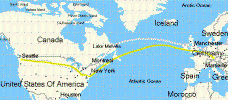
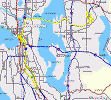
Overview maps: flights; Seattle
Private homepage – Hans-Georg Michna
Private News
Archive 2005-2007
Copyright © 2003-2023 Hans-Georg Michna.
Introduction
This page is meant for friends and relatives. New text was added at the top, below this block.
Actually, nowadays people would perhaps call this page a weblog, or blog in modern parlance. I never thought I'd do such a thing, or, rather, I already did it years before it became a fad. Most blogs are more oriented towards the outside, this one logs personal and family events, not web events.
Instructions for use
Please click on a small picture to see it enlarged. To get back to the main page after enlarging, click the back button on your browser or press the backspace key. If you want to obtain a higher-resolution version of one of the photos, please ask me by email.
If you cannot play a movie clip, install a matching codec or, more easily, install a capable video player, for example, Media Player Classic Home Cinema or the VideoLAN player (VLC) from www.videolan.org. Then download the video by right-clicking the link or picture below and selecting the command Save target as … Finally, open the AVI video file in the player.
Check out blog.michna.com! I have switched over to using that, rather than this page here, to announce personal news. It's just so much easier to use.
Please see http://michna.com/kenya2007/ for details.
I went to Seattle again for this year's Microsoft MVP Summit.


Overview maps: flights; Seattle
My flight led me through Philadelphia.
And continued to Seattle, where I moved into The Moore Hotel, a low-price place to spend the first two nights before the actual conference.
Even a cheap hotel in America can have free wireless Internet access, unlike most German hotels.
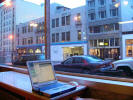
Wireless Internet connection in the lobby of The Moore Hotel
Sunday morning I did the Underground Tour, a fascinating trip into historic Seattle. Here's the history in short:
After a catastrophic fire that burned down all downtown Seattle, it was rebuilt with stone houses. In 1888, because of frequent flooding and unpleasant mud, the city built a rectangular, one-story-high retaining wall around each block of houses and filled the streets between these walls up to the height of one story. The idea was that the second floors of the buildings should eventually become first floors, while the former first floor would become a common basement.
At first there were ladders at every street intersection from the ground to street level, but in the following years massive steel beams were installed between the retaining walls and the houses just under street level, that supported new sidewalks at the new street level and turned the original street level into an extensive underground level for each entire block of houses. People could go underground via many staircases next to the houses or, of course, via the stairs inside the houses and could still enter and exit the houses through the original ground (now underground) level doors.
At the time of the Bubonic plague the underground level was declared unusable because of rats, but in fact it was never completely abandoned and is still being used in parts today. Other parts are private property and inaccessible, but some original parts of the underground level can be entered through the Underground Tour. The underground level is a rich source of historic artifacts and a fascinating piece of live history.




Underground Tour; the third picture shows one of the still existing original skylights
in today's sidewalk and our guide.
After the Underground Tour I walked through the Pike Street fish market near my hotel and continued to the Seattle Aquarium.

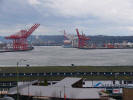

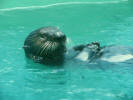
Pike Street Market, Seattle Aquarium
Today the conference registration begins, but I still have some free time. First I moved over to one of the conference hotels—the Red Lion on 5th Avenue.
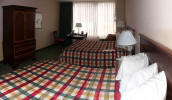
The window side of my room in the Red Lion Hotel
I went to register in the huge and very impressive Washington State Convention & Trade Center. Then I walked downtown and found the Klondike Gold Rush Museum.
The Klondike gold rush was one of the most interesting events in American history. In 1886 somebody found a significant amount of gold in a tributary to the Yukon river and mentioned it. This started the biggest gold rush in history, where over 100,000 people travelled north in the hope of finding gold.
Most of them arrived only after all the claims were already given to a few early comers. Many turned back, others worked for money either in the gold business or in the many secondary businesses that sprung up within a year. Whole cities, like the coastal starting points of Skagway and Dyea and the new city of Dawson in the gold area were built out of nothing. Other cities, like Tacoma and Seattle, benefitted greatly from the gold rush and provided the gold seekers with supplies and transportation.
The White Pass, one of the climbing routes from Skagway to the high Lake Lindeman, was also called the Dead Horse Pass, because many horses didn't make it through the very difficult terrain. Arrived at Lake Lindeman, people built boats for the long and treacherous journey to Dawson down the Yukon River.
I can only recommend to visit the very nice and informative museum in Seattle or perhaps to watch a documentary, read a book, or read a few web pages about the Klondike gold rush.
On my way to and from the museum, Seattle showed itself from its best side, in sunshine under a blue sky.
After a day of interesting sessions (and good food), the big party for all participants took place in the Museum of Flight.
The museum was very interesting, particularly the exhibitions of World War I and II planes.
The other days were filled with interesting sessions and meetings, and the summit ended Thursday afternoon. After one last night in the hotel, two other MVPs from Munich and I headed for the airport to catch our flight to Philadelphia and from there to Munich.
However, when we were already about to descend into Philadelphia airport, the pilot announced that all the coastal airports were either experiencing gridlock on the ground or were closed altogether, due to a snow storm involving freezing rain and sleet. He extended the air brakes and made a steep descent into Pittsburgh, 430 km short of Philadelphia.
We spent the rest of the day waiting in a long line for a new way out and finally got new bookings for flights two days later, on Sunday, to arrive in Munich on Monday. The long delays and huge waiting crowds were caused by a new computer system that US Airways had recently installed.
Halfway between the airport and the city we found a cheap little motel, "Red Roof", and spent the next two nights there.
The next day we visited the steel city, Pittsburgh.
We found that we had hit an old Irish holiday, St. Patrick's Day. The center of the city was blocked off for a parade.
Pittsburgh is located where the Monongahela and Allegheny rivers meet, so there are several bridges spanning the rivers.
Because it was too cold and windy for more walking, we stopped a taxi and drove back to the hotel and the neighboring diner named Denny's, where we had a good meal.

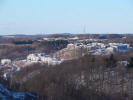
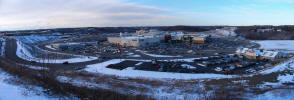
Photos from a little evening walk around the motel
Early in the morning we checked out of our motel and jumped onto the airport shuttle for another try to get back home. But even though we were there three hours before departure, it was another close call, because the new computer system of US Airways was still working very slowly, if at all.
But finally we were able to get into the plane, a Brazilian-made Embraer 170 with 72 passenger seats, heading for Philadelphia. On the way I saw the Harrisburg nuclear plant, built on Three Mile Island in the Susquehanna river.
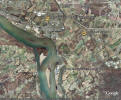
Google Earth image of the Three Mile Island Nuclear Generating Station
The pink line in the upper right is my GPS-recorded flight path.
Then we descended towards Philadelphia and flew a nice sightseeing curve around the city.
After the landing, the same story unfolded again. Endless lines in front of the few operating counters and waiting times of several hours. Meanwhile we had picked up a few fellow passengers with the same problem, all stranded in the snowstorm and unable to get off again soon due to the unworkable computer system.
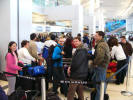
En-Tzu, Andre, Helmut, Torsten
Among them is En-Tzu from Taiwan (far left), studying in Chicago and trying to get to Paris to visit a friend, and Andre from Dresden (center, blue) on a business trip, now on a waiting list to get back home. To his right are Helmut and Torsten, my fellow MVPs coming with me from the Microsoft summit and also trying to get to Munich.
For a long time the check-in came to a complete halt and everybody was wondering what was going on. Apparently the new US Airways computer system was bringing everything to the brink of desaster. Then the processing moved on very slowly, and after hours we finally got to a counter and eventually got our boarding passes.
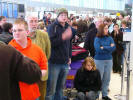

Passengers waiting at the ticket and check-in counters; warning sign at the
security check
All of us were again singled out for an extra-thorough security inspection. Then we headed straight for the MacDonalds restaurant in the security area and had our first bit of food this day.
An interesting detail was that a man walked around and reminded everyone to use one of the fingerprint machines to have your fingerprints and a photo taken before departure. The machine then spits out a piece of paper with an encoded printout that you're supposed to present at the security check before boarding the plane.
After another day on the airport, the plane arrived, two hours late, and took off, in spite of a three hour stop-over, still two hours late.
After spending the night flying, I finally made it back to home.
The snowstorm has apparently followed me here. It's now snowing in Munich.
I wrote an email to a friend in America today, which continues a discussion about movie theaters. The following is an excerpt from my latest email.
> Some comments:
>
> In the US, about 60 percent of movie admissions are for people 25 or
> younger. Those people go to the movies for the social experience, the
> actual film playing is not really that important.
That is an aspect I didn't think of. Particularly since young viewers make up such a large part of all movie-goers.
> I think 'pausing at will' causes you to see a different movie than the
> director made in some cases. With 'total immersion'(no interruptions) you
> get drawn MUCH deeper into the story than if you take a break to talk to
> someone, etc.
Not too bad, actually. If everybody is totally immersed, nobody will stop the movie. But many movies have boring stretches or are difficult to understand, and then the option of pausing the movie is good. Actually, we have an understanding that the movie experience is not to be disturbed. If somebody started to chat about other things, he would be reprimanded. On the other hand, when we watch a comedy and somebody makes a truly funny comment, that can be an art form. (There's even a German word for that: Zwischenruf. :-)
> All the theaters in our area have tiered stadium style seating so it's never
> an issue of being able to see the screen.
Yes, but when you sit in the back, you see a relatively small screen, and when you sit on a side, you see a distorted picture. I still remember the IMAX movie theater here in Munich, meanwhile closed and given up, which was good only when you sat in the middle.
> There are no noisy people in the theater we normally attend. You have
to be
> 18 to attend without a parent or other adult, among other things.
>
> We always know enough about a movie that wanting to abort watching it is
> never an issue. Once in a great while, one of us may not be too crazy about
> a movie but the other person may still like it (Babel being a case in point).
>
> I think we together saw around 30 or 32 films last year. My wife saw four
> or five more with either some of the kids or a family friend.
>
> Our weekly movie going is designed to give us 'together time' away from the
> usual full house of children and their friends.
>
> This time window is reserved, every week possible, for just the two of us.
> It's virtually impossible to watch more than one film in that time nor is
> movie going on another night a possibility.
>
> Not to mention I can't think of a small circle of friends that share our
> eclectic taste in movies.
>
> I could go on but I think you'll see are on quite different wavelengths.
I see your points, all valid. I think we are only seeing different aspects. My situation is tilted by our local movie theater offering very poor quality, and downtown Munich being a tad too far away for casual movie-going. Parking problems don't help either.
And so we're very happy to have a high-quality home cinema, which is getting a lot of use. If you check my movie list (at http://michna.com/movies.xls or http://michna.com/movies.htm) you'll find that we've meanwhile watched about a thousand movies, spread out over a number of years, but still quite a lot. We experience some saturation now. We are getting more choosy, and the number of queued TV recordings is going down at the moment, mainly due to the fact that we've already seen many of the better movies.
We rarely watch movies with an IMDB rating below 6 and concentrate on those above 7 (check www.imdb.com). We have for the most part stopped watching old movies (made before 1980), because we find them strangely out of touch with today's reality and because they are too slow.
We haven't been to a movie theater other than our own in quite some time, with the exception that the "kids" (18 and 20 now) very occasionally go with a group of friends.
Franz and I went to this year's go tournament in Erding again (www.go-erding.de). He finished on place 18 of 112, well in the 2-dan range, so his playing strength as a go master is confirmed.
I'm much weaker, but I won a prize for winning 4 out of the 5 games, which indicates that my strength increased. But this time I think it was luck. I won some games only because my opponents made mistakes.
Mausi and I went to a small Christmas eve trombone concert in Hohenbrunn. The trombone players were very good, which the recording through my small camera cannot reproduce. But you get an idea.
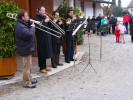

Short movie (WMV, 1.14 MB)
Best wishes for Christmas and the New Year to everyone! Enjoy a peaceful time.

(Danke, Andrea S., für dieses Bild!)
This page hasn't seen much activity recently, so I'll just pop a brief message in here.
I have some work and not much free time, which contributes to the long silence.
Georg has registered with the Ludwig Maximilian University here in Munich and has begun to study physics. Franz now also has a driver's license. Do we need more cars?
Yesterday and through the night it snowed relentlessly. Not uncommon for Germany, but a bit unusual in March, when it should slowly become warmer. Last night much of the road traffic was slowed to a crawl or broke down altogether. Some photos:
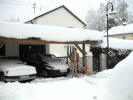
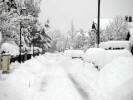
Trying to clear a path for the cars; our street with parked cars
Mostly it's fun, and luckily it's a weekend, so most people don't have to move. Tomorrow will be another matter.
Another MMM has taken place from Friday to Sunday. The video projector had kept giving me trouble, until I discovered that the cause was loose cooling fan contacts. Reseating those contacts has eliminated the problem, fortunately. Can't rely on anything these days.
But after this repair the Munich Movie Marathon in my living room was a big success.
On the annual go tournament in Erding near Munich the big winner was Franz, who has made an astounding career from some lower kyu grade to 1-dan, statistically even hinting at 2-dan. He won games against a 1-dan and two 2-dan players and succumbed only to a 3-dan.
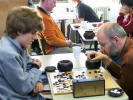
Our new go master Franz (left)
He even got some invitations to a German go league and to the European youth championship.
I won some games and lost some, altogether even. But it was good fun, and I've learned a few things.
If you don't know go, it's roughly similar to chess, two people putting stones on a board.
For me the oddest game was the last, in which I was behind at first. Still I allowed my opponent to take back a stupid move. Then I made a move and even warned my opponent about its possible consequences. He looked at it and cast my warning into the wind, which was a decisive mistake. I captured a large group of his stones, and the game now looked like a sure win.
I assumed he had given up, but still wanted to finish the game quickly to count, out of curiosity. I even chatted casually with a few kids watching the game and lost track of the ticking clock.
I very nearly lost on time and finally made a very stupid mistake, which led to the game becoming a draw (jigo), which is very rare in the game of go.
So what I've learned was that, at least in a tournament, one should finish each competition with some seriousness and concentration.
The reason why you read no news here is that I'm devoting more and more of my time to looking for work. This also means that I do few other things that are interesting enough to write about.
I find it hard to grasp that the market for freelance projects is so illiquid, but that's how it seems to be, a sad waste of time for me and of potential for those who could make use of my work. Or am I doing something fundamentally wrong? I can't think of anything, but then marketing is not my profession and none of my strengths, and so I always find it difficult to carry myself to market.
In any case, keep watching this space. Sooner or later there will be some news.
We had a server failure für michna.com including mail. The server was back up again on Monday morning.
We had our biannual movie marathon again, which lasted from Friday until Sunday. I'll just report on one movie that was perhaps the most impressive of the lot—Downfall (German: Der Untergang).
Let me first mention, however, that this time we tested a 5.1 surround sound system in the living room. First impressions are good. I hadn't thought it would be so good, and there were a few surprises.
One impressive effect didn't have anything to do with the surround sound at all, it was the bass coming from the big, powerful subwoofer. I hadn't thought that this would have such a big effect.
The other was the surround sound itself. Here I had reckoned that we would not benefit much from it, because two channel stereo is not too bad, and the action happens in front. I was basically right—indeed the surround sound plays a role only rarely and only in some movies, but the surprise is that I now think that in the few situations when you want it, you want it badly, and its effect can be very strong.
Downfall is a very German movie, maybe not so interesting abroad, but the war scenes with artillery coming in overhead, hitting, and sniper shots coming from and hitting on various sides were so realistic that I think the movie would lose an essential aspect without surround sound and the powerful bass. I've never been so immersed in war scenes, and watching this movie went beyond anything I could otherwise imagine.
In a few situations sniper bullets hit on the side and behind, and I instinctively swung around, until I realized that this was just the realistic soundscape.
The sounds in newer movies, particularly DTS sound, also cover a wider dynamic range. When you set the movie to normal loudness, i.e. voices being a bit louder than a real person talking in the room, then an incoming artillery shell hitting nearby is absolutely terrifying. I certainly lost my composure in some of these scenes and was immersed deeply enough to be genuinely shocked and horrified.
Much of the movie consists not of shooting scenes, but of social scenes in buildings, and these tell the true story of the almost unbelievable self-overestimation and the loss of touch with reality that gripped the leaders through their final days.
Some people rightfully criticized Downfall for euphemizing, and it certainly is, partly because you cannot show the true horrors of war in all detail. For example, you cannot show a torn human in detail on screen. Also some of the persons, particularly the doctor, Prof. Dr. Ernst-Günter Schenck (played by Christian Berkel) came across too positively as persons, because the movie didn't deal with some of the terrible things these people had actually done at other times.
To this I would argue that probably not every Nazi did only bad things all the time, and the movie only shows one short episode of the war—the last. If this movie would paint things in a black-and-white perspective, it would merely be a mirror image of a Nazi propaganda movie.
Altogether I think it's a real and good piece of coming to terms with the past. I recommend that movie to all who are interested in German history. The movie seems to be highly accurate, based also on interviews with people who were recently still alive, like Hitler's personal secretary Traudl Junge (played by Alexandra Maria Lara), who is the central figure of the entire story.
A more elaborate review of the movie is here.
I went to a meeting (MVP Summit) at Microsoft and, of course, took a few photos along the way. These were taken while overflying the coast of Greenland at 12 km altitude. Consider that the distance from the photographed objects was probably at least 20 km. Everything you can see on these pictures is very big.



Glaciers and icebergs at the coast of Greenland
When I arrived at the reception of the Westin Hotel, Seattle (if you have Google Earth installed, click here), the receptionist asked me whether I prefer higher or lower floors. I thought for a moment, then we both spoke at the same time. She said, "The lowest floors I have available, are ..." and I said, "Higher." She was relieved, dropped the sentence she had just begun, and gave me a room in the 38th floor with a wonderful view over Puget Sound.

Autostitched panorama picture, taken from my room
Only later it dawned on me that the question was because of widespread fear of terrorist attacks. Since I fear street traffic noise more than terrorist attacks, I'm quite happy up here. (I also drive and cross streets on foot, which certainly bears a much higher risk.)
Wednesday morning I took a little walk around the hotel, visited a lively market and looked at the city.
In the evenings there were dinners and meetings in various places, for example in the EMP (Experience Music Project) and Science-Fiction Museum.
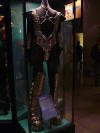
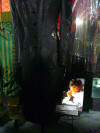
Costume of Gene Simmons, KISS Demon; costumes worn in Blade Runner, the black one
by Sean Young as Rachael

Detail from a large science-fiction history collage
After all the interesting technical details I learned in the sessions at Microsoft, one of the most striking impressions on the sidelines was that Microsoft, and to some large extent also the whole US and Canada, are incredibly multiracial places. Among the Microsoft project managers who held lectures for us, whites were in a minority. Most were from India and China, one of my contact persons at Microsoft is from Pakistan, one guy was, judging from his skin color and name (Abodabe Gbag..., forgot the rest), from Ivory Coast or one of the surrounding countries up to Nigeria. All were extremely competent, but also very nice people.
I asked some of them about this, and the ones I asked actually grew up in their original home countries and moved to America only later in life. Some others surely grew up in America already, but the world is apparently a place where people increasingly mix and move.
Here are my GPS tracks:



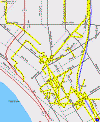
Flight; Greater Seattle; Seattle – Bellevue – Redmond; Seattle downtown
Meanwhile the interesting time is over, I'm back home and now have to get over
the next jet lag again, 9 hours time shift. After flying back from Seattle to Toronto,
Canada, I saw the sun set, boarded the plane, and two hours before landing in Munich,
the sun rose again. Confusing, this planet.
![]() Now
I am awake at night and sleepy during the day, will have to resynchronize.
Now
I am awake at night and sleepy during the day, will have to resynchronize.
Looking back to the Microsoft experience, I can say so much without breaking any NDAs: if the new Windows Vista™ will work as designed, it will be a fine operating system. [Addendum: As we later found out, it didn't.]
A friend and I bought a film scanner, a Nikon Super CoolScan 4000 ED (LS-4000 ED), and I have now begun to digitize my photo archive. The first results are here.
[Deutsche Version folgt unten.]
We built a few computers again, and I'd like to publish some observations.
The first is that this time everything worked. Perhaps we were just lucky, but in earlier computer building sessions we usually found at least one defective part.
The second is that this time for the first time I designed the computers for a later upgrade after 1.5 to 2 years. To be upgraded are the processor, the RAM (Random Access Memory), and the graphics adapter. Therefore we have relatively cheap types of these parts in the computers now, processor and graphics adapter around €150 and only 1 GB of RAM, which is later going to be expanded to 2 GB.
This harks back to the observation that the rise of demand for power has apparently slowed when you compare it to the rise of available power (Moore's Law). Earlier I had to swap computers after three years, upgrading didn't pay. Today they stay useful for 4 to 5 years, unless you're an extreme gamer, particularly with our planned upgrade step.
The third observation is particularly pleasant for me. I noticed that it is now possible, in spite of significantly higher power consumption, to build an almost entirely silent computer. The methods weren't even extreme—for example, the computers don't have water cooling. Instead it was entirely sufficient to combine the following components:
The graphics adapter has been selected for a good price-performance compromise and for the planned upgrade in approx. 2 years, but also for low noise. It has a ducted and speed-controlled radial fan, which also hardly contributes to any significant noise level.
The hard disk by Maxtor (still with 3 years manufacturer warranty) is also very quiet, but I didn't know that when I selected it.
Anyway, while I write this article, I have to listen carefully to hear that the computer is actually running.
I now use AMD processors. The planned upgrade is for a dual-core processor.
A nice detail is that the motherboard package included an adapter for two external SATA devices including power sockets. This is the simplest and cheapest way to put backups on external hard disks.
I append the list of parts below. If anybody wanted to build a similar computer, I can deliver some more details and information about a few traps into which I stumbled. Building such a computer requires some technical knowledge, but everybody should be able to do it with good instructions.
This is the invoice from e-bug, where I ordered most parts (prices in €):
| Article No. | Description | Pcs. | Price | Total | Total + VAT |
|---|---|---|---|---|---|
| 110020089 | Asus A8N-SLI Premium Socket 939 | 3 | 162.31 | 419.77 | 486.93 |
| 110019503 | AMD Athlon64 3000+ 1.8GHZ Boxed S 939 Venice | 3 | 138.52 | 358.24 | 415.56 |
| 110016640 | MSI 128MB MS-8983 NX6600GT-TD128 PCIe | 1 | 156.23 | 134.68 | 156.23 |
| 110019467 | MSI 128MB MS-8983 NX6600GT-TD128E Lite PCIe | 2 | 150.96 | 260.28 | 301.92 |
| 110009640 | Miditower Silentmaxx ST-11 black | 2 | 75.35 | 129.91 | 150.70 |
| 110009638 | Miditower Silentmaxx ST-11 white | 1 | 77.95 | 67.20 | 77.95 |
| 110017736 | Power supply be quiet! BQT Black P5-470W | 3 | 78.47 | 202.94 | 235.41 |
| 110021201 | Razer Diamondback Plasma Limited Edition | 1 | 39.56 | 34.11 | 39.56 |
| 110019519 | 300GB Maxtor 6L300S0 7200rpm S-ATA | 3 | 133.90 | 346.29 | 401.70 |
| 110019397 | DVD Burner S-ATA Plextor PX-716SA Retail white/black | 1 | 122.46 | 105.57 | 122.46 |
| 110005576 | Cherry Keyboard G83-6105 BLACK Win USB | 2 | 14.48 | 24.96 | 28.96 |
| Shipping insurance 0.99% | 1 | 24.13 | 20.80 | 24.13 | |
| Not from e-bug: | 1 GB Kingston SDRAM DDR 400 | 4 | 99.00 | 396.00 | 459.36 |
The RAM memory modules should only be bought in pairs, because otherwise you could never be sure to find matching ones for dual-channel operation.
Thus each computer cost almost exactly €1.000.
Wir haben mal wieder ein paar Computer gebaut, und ich möchte ein paar Beobachtungen veröffentlichen.
Die erste ist, dass diesmal alles funktioniert hat. Vielleicht haben wir nur Glück gehabt, aber früher hatten wir immer mindestens ein kaputtes Teil dabei.
Die zweite ist, dass ich diesmal erstmalig die Computer auf Zuwachs gestaltet habe, nämlich auf eine Aufrüstung nach 1,5 bis 2 Jahren. Aufgerüstet werden soll der Prozessor, das RAM (Random Access Memory) und der Grafikadapter. Daher stecken in den Computern jetzt relativ billige Teile, Prozessor und Grafikkarte so um die €150 und nur 1 GB RAM, der später auf 2 aufgestockt werden soll.
Das geht auf die Beobachtung zurück, dass der Anstieg des Leistungsbedarfs sich
anscheinend verlangsamt hat, wenn man ihn mit dem Anstieg des Leistungsangebots
(Mooresches Gesetz) vergleicht. Früher musste ich meine Computer nach drei Jahren
auswechseln, Aufrüsten lohnte sich nicht. Heute halten sie 4 bis 5 Jahre, wenn
man kein extremer Spieler ist, besonders mit der
Aufrüstungsstufe.
Die dritte Beobachtung ist für mich besonders angenehm. Ich habe festgestellt, dass es trotz erheblich höherer Leistung ohne Weiteres möglich ist, einen fast lautlosen Computer zu bauen. Die Methoden dazu waren nicht einmal extrem—die Computer haben z.B. keine Wasserkühlung. Sondern es reichte völlig aus, die folgenden Komponenten zu kombinieren:
Der Grafikadapter ist auf einen guten Preis-Leistungs-Kompromiss ausgesucht und auf den geplanten Austausch in ca. 2 Jahren, aber auch auf geringes Laufgeräusch. Er hat einen vollgekapselten und geregelten Radiallüfter, der ebenfalls kaum zu einem Geräuschpegel beiträgt.
Die Festplatte von Maxtor (immer noch mit 3 Jahren Werksgarantie) ist auch sehr leise, aber das wusste ich vorher nicht.
Jedenfalls habe ich Mühe, während ich diesen Artikel schreibe, zu hören, dass der Computer läuft.
Ich verwende jetzt AMD-Prozessoren. Die geplante Aufrüstung sieht einen Zweikern-Prozessor vor.
Ein nettes Detail ist, dass beim Motherboard ein Adapter für zwei externe SATA-Anschlüsse samt Stromversorgung dabei war. Das ist die einfachste und billigste Methode für Backups auf externe Festplatten.
Ich hänge die Stückliste unten an. Falls jemand diesen Computer nachbauen möchte, kann ich ein paar Details und Informationen über ein paar Fallen, in die ich gestolpert bin, nachliefern. Der Computerbau erfordert einige technische Kenntnisse, aber unter Anleitung sollte es jeder schaffen.
Rechnung von e-bug, wo ich die meisten Teile bestellt hatte:
| Artikelnummer | Beschreibung | Menge | VK-Preis | Total | Total + MwSt |
|---|---|---|---|---|---|
| 110019519 | 300GB Maxtor 6L300S0 7200rpm S-ATA | 3 | 133,90 | 346,29 | 401,70 |
| 110020089 | Asus A8N-SLI Premium Sockel 939 | 3 | 162,31 | 419,77 | 486,93 |
| 110019503 | AMD Athlon64 3000+ 1.8GHZ Boxed S 939 Venice | 3 | 138,52 | 358,24 | 415,56 |
| 110016640 | MSI 128MB MS-8983 NX6600GT-TD128 PCIe | 1 | 156,23 | 134,68 | 156,23 |
| 110019467 | MSI 128MB MS-8983 NX6600GT-TD128E Lite PCIe | 2 | 150,96 | 260,28 | 301,92 |
| 110009640 | Miditower Silentmaxx ST-11 schwarz | 2 | 75,35 | 129,91 | 150,70 |
| 110009638 | Miditower Silentmaxx ST-11 weiß | 1 | 77,95 | 67,20 | 77,95 |
| 110017736 | Netzteil be quiet! BQT Black P5-470W | 3 | 78,47 | 202,94 | 235,41 |
| 110021201 | Razer Diamondback Plasma Limited Edition | 1 | 39,56 | 34,11 | 39,56 |
| 110019397 | DVD Brenner S-ATA Plextor PX-716SA Retail weiss/schwarz | 1 | 122,46 | 105,57 | 122,46 |
| 110005576 | Cherry Keyboard G83-6105 BLACK Win USB | 2 | 14,48 | 24,96 | 28,96 |
| Versandversicherung 0,99% | 1 | 24,13 | 20,80 | 24,13 | |
| Nicht von e-bug: | 1 GB Kingston SDRAM DDR 400 | 4 | 99,00 | 396,00 | 459,36 |
Die Speichermodule sollte man nur paarweise kaufen, weil man sonst nie sicher ist, später die passenden für Dual-Channel-Betrieb zu kriegen.
So kostete jeder Computer fast genau €1.000.
[Deutsche Version folgt unten.]
A short vacation week led me into the east of Germany, particularly to Dresden and the tiny, totally unknown village Rutzkau.
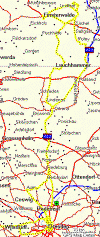
Journey through the former GDR
In Dresden the architectural mixture of three periods impressed me, namely the pre-war time, the communist time of the GDR, and the time after the reunification. Many buildings and streets have been renovated with great effort, but many houses and appartments are nonetheless unoccupied. A few photos:
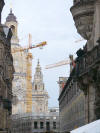

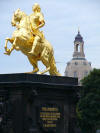
Different views on the recently rebuilt Frauenkirche (womens' church); the Golden
Knight

The forests are full of boletus mushrooms


A lignite (brown coal) strip mining impression from the area near Lauchhammer;
windmill generators behind an exhausted mine



Combine harvesters on the big fields; offloading the harvested and threshed wheat
East Germany has comparably huge fields, a result of the forced collectivization during its communist past. I watched a platoon of five combine harvesters finishing off a field while driving in formation.
Eine kurze Urlaubswoche galt dem Osten Deutschlands, insbesondere Dresden und dem winzigen, völlig unbekannten Dorf Rutzkau.
Mich hat besonders in Dresden die architektonische Mischung dreier Epochen beeindruckt, nämlich der Vorkriegszeit, der DDR-Zeit und der Zeit nach der Wende. Viele Gebäude und Straßen sind aufwendig saniert, aber viele Häuser und Wohnungen stehen trotzdem leer. Hier ein paar Fotos.



Verschiedene Blicke auf die kürzlich wiedererbaute Frauenkirche; der Goldene Reiter

Die Wälder sind voller Steinpilze


Braunkohle-Tagebau-Impressionen aus der Gegend von Lauchhammer;
Windmühlen-Generatoren hinter einem verlassenen Tagebau



Mähdrescher auf den großen Feldern; Abladen des geernteten und gedroschenen Weizens
Die ehemalige DDR hat vergleichsweise riesige Felder, ein Ergebnis der Zwangskollektivierung während ihrer kommunistischen Vergangenheit. Ich beobachtete eine Formation von fünf Mähdreschern beim Abernten eines Feldes.
My job in Magdeburg has ended. It was OK as long as it lasted, but I'm also glad I don't have such a long way to work any more.
[Deutsche Version folgt unten.]
In Magdeburg this theater play was performed in the garden of the bailiwick. From the announcement:
This summer POETENPACK continues with “Measure for Measure” the round dance of Shakespeare's comedies. At well-known and new places we will set up our stage and take you away into Shakespeare's world, which is apparently closely related to ours today.
For long years Duke Vincentio conducted his official duties loosely and let the morals in his fief decay. Now Angelo, the upright defender of decency and morality, whom Vincentio instates as his deputy, shall put things right again, while the duke himself goes on a journey. Disguised as a monk, however, he returns early and unrecognized and can thus watch astounding incidents.
Young Claudio loves his Julia, wants to marry her and has already made her pregnant. No longer to tolerate premarital sex, Angelo wants to have this case punished by decollating Claudio. He would, however, let himself soften into an amnesty by a love night with the sister of the sentenced, young nun Isabella. A big game of confusion of love, passion, morale, belief, and power ensues. In the background the duke takes corrective action, prevents the worst, and leads everything to an astonishing end.
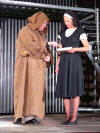

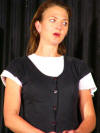
Theater play in the garden of the Möllen bailiwick in Magdeburg
I was there and I liked it. It is good to see that it is still possible to attract an audience into a theater without pompous buildings and stages.
In Magdeburg wurde im Vogteigarten dieses Theaterstück aufgeführt. Aus der Ankündigung:
In diesem Sommer setzt POETENPACK mit „Maß für Maß“ den Reigen von Shakespeares Komödien fort. An altbekannten und neuen Spielorten werden wir unsere Bühne aufbauen und Sie für einen Abend in Shakespeares Welt entführen, die augenscheinlich viel mit der heutigen zu tun hat.
Lange Jahre ließ Herzog Vincentio seine Amtsgeschäfte schleifen und die Sitten in seinem Reiche verwildern. Dies soll nun Angelo, der aufrechte Verfechter von Anstand und Moral, den Vincentio als seinen Stellvertreter einsetzt, wieder richten, während sich der Herzog selbst auf eine Reise begibt. Als Mönch verkleidet kehrt er jedoch unerkannt vorzeitig zurück und kann so erstaunliche Geschehnisse beobachten.
Der junge Claudio liebt seine Julia, will sie heiraten und hat sie bereits geschwängert. Vorehelichen Sex nicht länger duldend will Angelo diesen Umstand durch Abschlagen von Claudios Kopf bestraft wissen. Zu einer Begnadigung ließe er sich jedoch für eine Liebesnacht mit der Schwester des Verurteilten, der jungen Nonne Isabella erweichen. Es beginnt ein großes Verwirrspiel um Liebe, Leidenschaft, Moral, Glauben, Macht. Im Hintergrund greift der Herzog lenkend ein, verhindert Schlimmeres und führt alles zu einem erstaunlichen Ende.



Theateraufführung im Garten der Möllenvogtei in Magdeburg
Ich war da, und es hat mir sehr gut gefallen. Es ist schön, zu sehen, dass es noch ein Theater gibt, das Zuschauer auch ohne pompöse Gebäude und Bühnen anlocken kann.
This time I will try to write a little travel report about a trip that is probably normal and boring for most other people who do this often. For me, however, it was a little adventure, because I very rarely travel by train. It may also be interesting for people who don't know Germany.
This week and the next I could neither fly to Magdeburg, nor use the car, mainly because I was going to attend the funeral of Mausi's mother in Berlin on the next weekend. So I decided to make good on an old plan and try the train.
My experiences with public transportation even in Germany, a country so much dedicated to subsidizing a hugely loss-making endeavor like the rail system, had been poor, so I was skeptical. Nonetheless I set out to try it again.
A friend had given me a free, unlimited distance within Germany trial ticket, so the opportunity was enticing. Mausi took me to the Ottobrunn S-Bahn station around 21:30 o'clock.
For those unfamiliar with the German rail system, S-Bahn is an abbreviation of Stadt-Bahn, city train. The S-Bahn system is a network of city rail lines with trains usually going every 20 minutes. In the city center the trains go underground like the U-Bahn (underground train), which coexists in Munich.
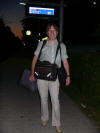
At the Ottobrunn S-Bahn station just after sunset
Despite the Germans' (probably obsolete) reputation for punctuality, the city train was late by 5 minutes. Fortunately I had planned some buffer time, so this didn't create any risk of missing the next train, but had I taken the last possible city train, I would have missed my connection.
Then the S-Bahn came and I rode it for some 25 minutes into the city centre of Munich, where the train dives down into the inner city tunnel system, where the S-Bahn and the U-Bahn (underground train system) criss-cross each other in several levels.
While I glided up the escalators to the train level at the surface and wound my way through the station, I passed several ticket counters that were already closed, so I proceeded to the main hall counters. A few people were waiting in line, but it wasn't too bad.

Waiting in line at the few open ticket and reservation counters
A few mintes later I was talking to the friendly and competent lady behind the counter, explaining that I had a free ticket, but now wanted to upgrade as far as possible and take a sleeper cabin in the night train, leaving around 23:00 and arriving in Halle around 5:00 in the morning.
She explained in impressively clear, easy-to-understand sentences that my free ticket doesn't allow any upgrades to first class, but she could give me one of two beds in a second class sleeper cabin. I gladly accepted, paid €60 by Maestro debit card for the upgrade, and walked back into the train area of the station.
I still had some time, so I took a few more photos.

Munich central train station at night
Several trains were waiting to depart. On one side there was a fast InterCityExpress train. On the other side I saw a regional double-decker train, where people entered to get home before midnight.


InterCityExpress train; regional double-decker train
Then my night train arrived. To my surprise it was also an auto train with several car transporter wagons. People use these to avoid driving a thousand or more kilometers to the place of their vacation, but still take their car with them, so they are mobile at their destination.


Night train with car transport wagons; Deutsche Bahn Nachtzug (German rail night
train)
Curiously I entered this unusual-looking train. It was low, much lower than the car transporters, and it had fewer windows than ordinary trains.
I found my wagon and my reserved cabin.
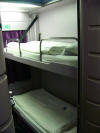
Second class cabin with two berths
At this moment the conductor came and asked me about my destination and my wishes, like coffee or tea in the morning. I declined, but asked him to wake me up 15 minutes before arrival.
He then pulled out his schedule, thought for a moment, then proposed to move me to a different cabin where I could most likely be sure to stay on my own. I gladly accepted and followed him to the other cabin.
There was very little free space, so even putting my bag down already blocked either the entrance door or another door inside the cabin. But then I discovered the foldable ladder and a large luggage space opposite the beds at the ceiling.
The cabin also had a window, which was covered by a dark curtain. I opened the curtain, so I could look out and also put my GPS next to the window to record my night travels.
I opened the other door and found the bathroom with a toilet, a washing basin, and a shower.
Of course I had to try the shower, so after the train had begun to roll out of Munich, I brushed my teeth and took a nice shower, which felt very good after having toted my luggage all across the main station and sweated in the warm summer night and the even warmer lower levels of the train station.
Finally I went to bed as the train passed through Augsburg and tried to sleep. Lights passed by the window and flashed into my eyes from time to time, so I closed the curtain and went to bed again.
However, I found that, in spite of my very good ear plugs, the wheels of a train make a lot of noise, particularly when it wends its way through the curves of hilly areas like the Mittelgebirge, the middle mountains of Germany. I could not sleep much. Only when the train stopped or went slowly or drove along some absolutely straight rails, I could catch some sleep.
Fortunately the train did stop from time to time. It is a relatively slow train, following the night train rule that there should be no station stop between 0 and 5 o'clock.
Beep beep—an obnoxious sound tore me brutally out of a phase of deep sleep. It was the telephone that woke me, just as I had ordered. I lifted the receiver, listened to a recording for a moment, and hung up again, to silence the nasty thing.
The train wasn't moving. Had we already arrived in Halle? I got up and pulled the curtain aside to look out. In the first trace of dawn I saw that we had stopped in the middle of nowhere, so I relaxed, switched on the light, switched off the alarm in my mobile phone that I had set, just in case, dressed, shaved, and got ready to leave the train that had meanwhile begun to move again. A few minutes later we rolled into Halle main station, and I got out of my rolling hotel.
According to my plan I now had over an hour waiting time until my next train left for Magdeburg main station, so I slowly walked along the platform, then stopped to read a departure table. I found my next train on it as expected, but then I saw that that train runs hourly, and the previous one would leave in one minute.
The prospect to save one hour made me run. I raced down the stairs and along the tunnel to the departure platform. In theory I should now have seen the train roll out of the station, but there was no train there. At that moment an announcement came over the speakers, pronouncing that the train was 5 minutes late. I was angry at the Web connection search system that had found the connection for me, but neglected to inform me about this short, but quite possible, and much faster connection. Apparently one needs some experience to make the best of the German railroad system.
Five minutes later the train arrived, and I entered it. This was an InterCity train (not InterCityExpress) that usually moves at 160 km/h, as I later measured with the GPS. It turned out to be quite convenient and even had power sockets near the tables, so one can use a laptop for longer than its batteries last. The trip took about an hour, with two intermediate stops, so I did just that and wrote this little travel report.
While I was rolling on mostly perfectly straight rails through the flatlands of northern Germany, watching birds of prey fly over in search of an early breakfast, the sun rose. Just before 6 o'clock the train rolled into Magdeburg main station, where I had to change trains one last time for a three minute ride to the next local station, Magdeburg Neustadt.
I got out of the InterCity, took the photos you're seeing here, and entered the regional train that was already waiting on the other side of the same platform. This was a two story train, built to carry the largest possible number of people over short distances.

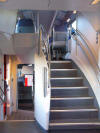
Regional train outside and inside
I didn't even bother to sit down and left the train again at the small Magdeburg Neustadt station, an old building, showing some ancient-looking architecture.

The old Magdeburg Neustadt train station
Then I walked the few steps to my work place. Another little adventure has come to an end, but I'll still feel the aftermath until I get a good night's sleep tonight.
All in all my final judgment ist that I won't do this again. The German rail company has done its best to do almost everything right, but they couldn't solve the one and only major remaining problem, the wheel noise. What good is the nicest bed and the nicest cabin with bathroom if in the end you cannot sleep? So the next time, if I have to go by rail at all, I'll go on Sunday afternoon and rent a hotel room for the extra night, which, in Magdeburg, is cheaper than the bed in the sleeper cabin.
Mausi's mother died shortly before her 95th birthday. She died of old age, meaning that many bodily functions failed at the same time.
She had been taken to hospital with difficulties to breathe and to cough. On the 9th of July she was to be released from hospital. Mausi and her sister went there to collect her, but, minutes before they arrived, she had died a peaceful death.
I still have to travel to work in Magdeburg on Monday morning and return Friday night. Since the drive is stressful in spite of the mostly six-lane freeway, particularly when driving in the dark, I have now decided that I will fly whenever possible. Since there is no scheduled service to the small airport in Magdeburg, I use planes of the Munich flying club (Fliegerverein München), of which I am a member, so I get discounted prices.
I have recently flown Cessna 172 and 152 planes to Magdeburg, which takes the better part of 3 hours, particularly in the Cessna 152, a gracile, beautiful, but relatively slow airplane. But now I was offered a Mooney Ranger.
The Mooney is a legendary airplane. I've read a lot about it in flying magazines in those times when the Mooney was the plane everybody wanted to have.
What's so special about it? The Mooney is a four-seater, designed for speed. It is not very spacious, but cleverly designed. Getting in and out is difficult, but once you've settled into your seat, it is quite comfortable.
The biggest new thing for me is that it can retract its wheels. With a constant-speed propeller and retractable gear it counts into the class of sophisticated singles, which is a first for me, but certainly makes a good impression in the pilot logbook.
So I was looking forward to using the Mooney, and had a type familiarization and check flight with an instructor yesterday. After some flying and a number of touch & go training circuits in Eggenfelden I was deemed capable of piloting the Mooney and planned to use it this morning.
My starting point was Landshut airport, a beautiful little airfield near Munich, where the Mooney is stationed. They open at 9, but after some preparation it is permissible to use the field outside of opening times, uncontrolled, so I planned to take off at the earliest possible time, 6 o'clock in the morning. Mausi drove me there, because she needed the car, and she helped me pull the plane out of the hangar.
It was a beautiful morning with a sun that had just risen into the clear, blue sky. The airport was totally quiet. We were the only people there at this early time, and after she had left, I was there all by myself.


Preparing the Mooney in the morning
I prepared the plane, attached my GPS to the windshield, and went through the checks. There were already two other GPS receivers in the plane, but I prefer to use my own, not least, because I had already programmed the route into it, which should lead me almost straight to the north, approximately along the Regensburg Autobahn, through a narrow passage between the Hof control zone and the Czech border.
Of course, in good weather I could fly above the control zone and wouldn't need to worry about it, but I try to prepare the routes such that they work in bad weather as well. The main features of my route are that I leave Nürnberg on my left side, then turn slightly to the left to have Erfurt to my right. Both cities have major airports along with their terminal control areas, which I should avoid.
Then I arrived at Magdeburg after only 1 hour and 40 minutes, 10 minutes before the Magdeburg airport opens. I called them, but nobody answered, so I did a little sightseeing across the river Elbe while calling Magdeburg from time to time. A few minutes later I got a reply and could now legally land.
Now I had to do something I did not have to do before—lower the gear. In the first Mooneys this was done by muscle power with a big lever, but the newer ones like this do it through an electrical switch, just like the airliners. The big problem is that you can forget it and land on the belly, which usually destroys the propeller, the engine and much of the airframe.
To avoid relying entirely on the pilot's unreliable brain, the Mooney issues a high whistle when you reduce the power while the gear is still up, and, of course, I didn't forget it anyway in my first landing, but I'm still thinking about means to make sure I'll never land on my belly.
Now I fully realized how fast this airplane is. Covering a distance of over 400 km in only 1:40 h means an average speed of 240 km/h, much faster than the Cessnas I used to fly before. Indeed the travelling speed at 75% power under perfect conditions is some 250 km/h according to the manual, with 280 km/h being the maximal structural cruise speed. This airplane is impressive.
Tying down the plane in Magdeburg is awkward, because I have to tote the heavy weights to the airplane every time. Then I covered the plane with its tarpaulin and took a taxi to work.
Compared to the car, the plane is not only faster, but also much less stressful and, I believe, much safer.
Friday afternoon, after a week of work, I flew back with a friend. It was his first flight in a light airplane, but he took the controls early on and flew us back all the way to Landshut. He seems to be a natural flying talent.
This left me a little time to take a few aerial photographs. First we flew over a little village where some friends were born, and later we passed by Regensburg.
A few minutes later we landed in Landshut. In spite of the initially poor weather forecast this was a very beautiful flight again.
The next week I flew again. Here are some typical routes.
The slightly curved route is necessary, because, coming from Magdeburg, I have to circumvent the control zone of the airport Leipzig-Halle in the west, then the Erfurt control zone in the east, in other words, fly between the two. Then I avoid the control zones of the airports Hof and Nuremberg on the eastern side and therefore fly very close to the Czech border, and finally roughly along the Autobahn (freeway) A93 via Weiden and Regensburg almost exactly southerly to Landshut.
An alternative route I use when flying from or to Augsburg or when the weather is too bad for the middle mountains (Mittelgebirge, Erzgebirge, Thüringer Wald) leads westerly past all airports named here and via Eisenach around the Thüringer Wald in the west. If one day the weather forces me off course, I could also change over from one of these routes to the other, for example, crossing to the south of the Erzgebirge and the Thüringer Wald.
See the travel report at michna.com/kenya2005/.
I wrote a page at michna.com/notlandung.htm about the whole event, but it is all in German. Haven't found the time to translate it yet and am not sure whether I'll ever find it. Let's see. You may want to look at it anyway, because of the pictures, including the GPS track maps.
In short, I flew visually from southern Germany to the north in poor, but flyable weather and got caught in a cloud trap in the middle German mountain formation called Thüringer Wald near a place called Eisenach (the place where Martin Luther dwelled in the Wartburg castle).
I had a large system of valleys all to myself and could leisurely fly up and down, left and right, from one valley into the next and the one thereafter, but all attempts to leave the whole area failed at impenetrable cloud walls, even my later attempts to fly back south. Altogether I criss-crossed the area for about 2 hours. Had never experienced anything like this before. The GPS track looks like a spider web.
Very unfortunately this is one of the few areas in Germany without any known and active airfield, so I eventually got used to the thought that I would have to land somewhere. So I spent the second of the two hours checking out roads, fields, and farm tracks.

My spacious prison cell between the clouds
I learned that this is a time-consuming task, because often you can see certain types of obstacles only from low altitude. I ended up checking two stretches of road, which turned out to be unsuitable due to trees, and a track between fields, leading from a road to the edge of the forest, and decided to use that.
Called up air traffic control, explained my situation and intentions and asked them for their telephone number, in case the radio would no longer be able to make contact on the ground between the mountains. They were very concerned and wanted to help, but couldn't. But they could sense my total calmness and were at least quite happy that I didn't panic.
As you know, I'm a bush pilot with most of my experience gained from bush flying in Africa, so landing the plane on such a track is almost a normal landing for me. I strove for maximum precision and landed the plane perfectly on the narrow track that allowed less than 2 ft leeway for the wheels, left or right.
After the landing I called up air traffic control on the mobile phone and told them that everything went well.
Then some funny things happened. The police came and looked, several other cars stopped and drove up to the plane, out of curiosity, then the local press got wind and reporters turned up.
I called a taxi and fled into a really nice hotel more or less underneath the Wartburg castle.
The next morning I went back to the plane and prepared the takeoff, which is easier than the landing, but it is more difficult to keep the plane precisely in the tracks under full power.
That day even the local TV station showed up and interviewed me—a somewhat doubtful way to fame, as my situation wasn't exactly something to be proud of.
To cut the long story short, the takeoff went exactly as planned, and I arrived at my final destination one day late.
Along with the faster Internet connection we got a new ISDN telephone line, so we gave up the old one. Mausi kept her number, mine changed.
A friend loaned us an old ISDN telephone system, which, however, turned out to be barely usable and partly defective. So we bought a new one, from Siemens. The small base station with answering machine is an SX 445 isdn and the matching wireless phones are called S44.
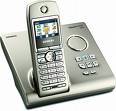
Siemens SX 445 isdn
While still far from the capabilities of a modern mobile phone, the devices are at least easily usable, and the functions and menus work mostly as expected. Altogether I can recommend these devices. They are the best Siemens has to offer, and there doesn't seem to be much competition in this field.
The built-in clock seems to be late though. Again one of these many cases where technical things harbor strange defects where one isn't quite sure whether it would be better to send them back or not.
The new telephones have some nice functions that I have to test and learn first, like callback (CCBS = Completion of Calls to Busy Subscriber, CCNR = Completion of Calls to No Reply). I have already seen that the service provider supports these functions.
(Eine deutsche Version folgt anschließend.)
With our neighbors we went to Master cook Schuhbeck's mirror tent palazzo and spent an evening with excellent food and the best and most pleasant entertainment. Initially I was skeptical.
Besides the food there were various performers, showing off their arts, for example the bottle musician, who could play the most incredible tunes on half-filled bottles.
Besides some very funny comedians there were several dancers and artists (see the trapeze artist below), who were great fun to watch.
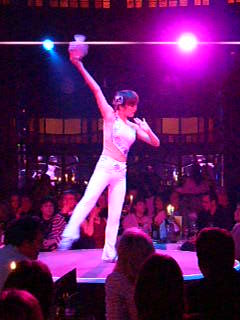
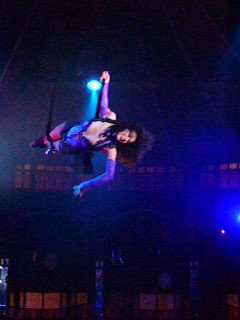
Chinese dancer and trapeze artist
(Click on a picture to watch the video.)
My skepticism turned out to have been unfounded. It was a very felicitous evening.
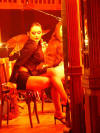
Dancer's break between performances
Wir sind mit unseren Nachbarn in Meisterkoch Schuhbecks Spiegelzelt-Palast gegangen und haben dort einen Abend bei bestem Essen und kurzweiliger Unterhaltung verbracht. Ich war erst skeptisch.
Neben dem Essen gab es verschiedenste Künstler und Artisten, die ihr Können zur Schau stellten, z.B. den Flaschenmusiker, der unglaublich gut auf halb gefüllten Flaschen Musik machen konnte.
Neben den ziemlich ulkigen Spaßmachern gab es mehrere Tänzerinnen und Artistinnen, bei denen das Zusehen die Sinne erfreute.


Chinesische Tänzerin und Trapez-Artistin
(Klicken Sie auf ein Bild, um ein Video zu sehen.)
Meine Skepsis stellte sich als unbegründet heraus. Es war ein sehr gelungener Abend.
The kids convinced me that we need a faster, better, and fortunately also cheaper (or at least not more expensive) Internet connection. So we changed from Telekom/T-Online to Arcor, a local company that has reached our place with their newly growing cable network.
So now we are getting a new ISDN connection and a new, faster ADSL connection over the same two old, thin, twisted telephone wires. We avoided ISDN before, but now we were forced to take it, and it will indeed save us some money, because it has two telephone channels, rather than one, so we need only this one connection and not two, as before.
Our telephone numbers will change. Only Mausi keeps her number, +49 89 605064.
Everybody else gets a new one. (An ISDN line can have up to 8 numbers.) Here they
are: +49 89 66060854; +49 89 66060855; +49 89 60011331. I'll take the last one,
even though it sounds like a sex line.
![]()
The ADSL channel has 3 Mbit/s down and 512 Kbit/s up. Actually the upload rate is more important for us because of file sharing.
Today we laid some new cables. We wanted the ISDN wire to come up from the basement to the ground floor, because our (also new) wireless ISDN telephone base station and also the WLAN base station should reach the entire house, which has been a problem with the WLAN before. It doesn't reach from the basement to the second floor. Now it will cover the entire house and will have excellent coverage in the living room. We provide the WLAN for our laptops and for guest computers, in addition to the 100Base-TX cabling with sockets in most rooms.
We had to modify the existing telephone wiring to get the ISDN signal up while cutting the lines to all other telephone sockets, which we no longer need and which would cause problems if they remained connected. And we had to lead the computer network Ethernet back down, because the central switches are in the guest room in the basement and cannot be relocated.
So we had a family happening. Everybody joined in, and the four of us did all the work together while having some stress when things were difficult, like nails not staying in the wall, but also a lot of fun, as you can see here.
The upper middle picture shows the central switchboard
![]() on the
right side. It carries the two switches that link all Ethernet sockets in the house.
It is in the guest room in the basement, and we provide a cover, so our guests
aren't kept awake at night by the always flickering lights.
on the
right side. It carries the two switches that link all Ethernet sockets in the house.
It is in the guest room in the basement, and we provide a cover, so our guests
aren't kept awake at night by the always flickering lights.
Why do they always flicker? Because at least one computer is always on in the house, downloading and uploading files from and to the Internet.
We used to have a switch with a cooling fan before, but that didn't play well with guests at all. So we soon gave it away and now have the two tiny switches that you can see in the photo.
Since the Cat. 5 cable carries two connections, the new setup will also allow us to feed two separate virtual networks, so Franz can play unimpeded by the incessant file transfers. More precisely, he can throttle them a bit when he needs a low ping/lag, by remotely controlling the virtual network settings in our excellent, powerful and reliable DrayTek Vigor 2500We router.
First measurements today show zero errors on the ADSL link, which is very encouraging, in spite of the considerable distance of probably over 2.5 km to the DSLAM (Digital Subscriber Line Access Multiplexer).
Franz and I and two friends from Magdeburg went to the Go tournament in Erding. Some photos are here.
We played well. Each of us won a few games and lost at least one.
I'm happy that one of my photos was selected for a book cover:
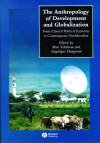
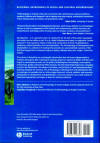
"The Anthropology of Development and Globalization", front and back cover
![]()
Detail from back cover
The photo was one of the first I took with my new digital camera. I worked on it for quite a while and moved and waited until the composition was right. Fortunately I was alone at the time, because I'm sure that any passengers would have lost patience long before I actually took the final photo.
If you find typos, orthographic errors (even small ones), ungrammatical sentences, wrong or illogical information in this text, or if you want me to write more details about something in particular, please click on the email sign below and draw my attention to the point. Many thanks!
Copyright © 2003-2023 Hans-Georg Michna.
Private homepage – Hans-Georg Michna
hits since 2007-11-01
Free PHP scripts by PHPJunkYard.com